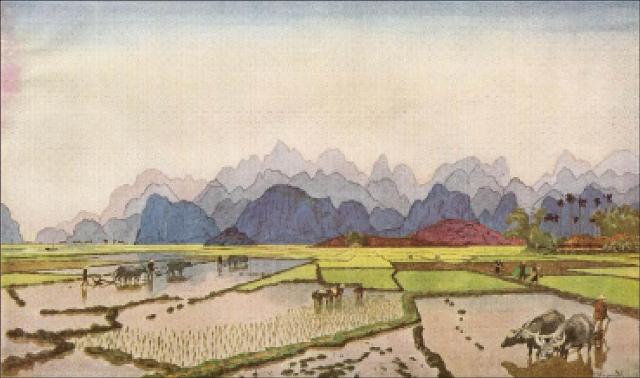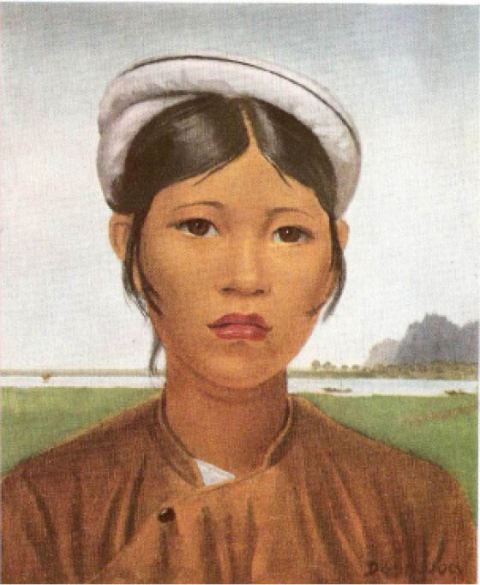Artist Jean Despujols was born on March, 19th, 1886 in Salles, France. He won first prize for his oil paintings in Rome in 1914 and the Indo-China painting in 1936. Through oil paintings, watercolors and even pencil sketches, he completely ignored the notion of colonialism. With the eyes of art and true feelings of the soul, he recorded images of the land and people of Vietnam and Indochina with deep understandings and sympathy.

The painting depicting 99 mountains in Phu Tho
The cause behind the painting of a Hue girl
In the Trang An Newspaper, published in Hue before 1945, No. 251 on 31/8/1937, an article titled "Painter Despujols coming to Hue"reported: "French painter Jean Despujols has come to Hue this week. On painting, Despujols won a Roman first prize and a French first prize. Despujols was a friend of the nuncio Graffeuit. This is the first time he comes to Hue and he will stay here for a long period, in order to have enough time to paint the famous landscapes of the capital. "
In a long report titled "Indochinese Portrait with 21 Drawings by Jean Despujols," published in National Geographic magazine, two authors, W.Robert Moore and Maynard Owen Williams, covered some interesting information on Jean Despujols and his paintings. Two authors wrote that Jean Despujols created about 300 paintings in Indochina, reflecting the society, customs, festivals, landscapes and people of Indochina.

Portrait of a Hue girl named Yen
Artist Jean Despujols painted many faces of girls from Vietnam, Laos and Cambodia with a delicate and harmonious style, which is very close to the aesthetic of Vietnamese people. And among these many portraits, there is a portrait of a Hue girl.
Among the 21 paintings presented, painting No. 13 depictsa Hue girl named Yen, and No. 14 shows a northern girl named Xuan. The article commented: "The elegance of the Central girl and the fitness of the Northerngirl reflect the contrast between the Vietnamese ethnic origins. Yen was planting rice near Hue, where the old An Nam court was located. When the artist found her, he commented: ‘On her obvious grace and poise, the former poet and emperors must be responsible as they recruited the most beautiful women in the country to serve in theircourt.’ Xuan ‘becamesour and hard’ by her poverty. Growing rice, embanking dykes, and giving birth is her fate. The breath of resentment seemed to emerge through her lips."
Unfortunately, in the report, W.Robert Moore and Maynard Owen Williams introduced only the picture of Yen. With the long stay in Hue as the Trang An Newspaper reported, Despujols would have probably painted many more pictures of the capital.
The Meadows Museum - preserving the image of Vietnam through the paintings of Despujols
Despujols’ Indochinese painting collection was nearly lost, when it was moved from France to the United States. However, inexplicable luck had brought the paintings to the United States, where they were first displayed at the State Museum of Louisiana and the Smithsonian in 1950.

A Northern girl named Xuan
In April 1951, National Geographic magazine selected 21 paintings in this collection to illustrate the "Portrait of Indochina",and later the paintings have been stored in a wooden chest for 18 years. In May 1969, Algur H. Meadows bought all of Despujols' paintings and donated them to Centenary College. So, Algur H. Meadows is considered the founder and sponsor of the Museum of Art named after him - Meadows Museum.
This museum is located in Shreveport, a small town located in the State of Louisiana in the South of the United States, solely for displaying a collection of paintings by artist Jean Despujoils painted during his Indochina journey,which startedin late 1936.
Of the 21 paintings by Despujols published by W.Robert Moore and Maynard Owen Williams in National Geographic magazine, there were many of paintings of the country and people of Cambodia and Laos. We could see the Apsara dances on the ruined Angkor background. We could see Cambodian young women holding sacred lotus buds and dancers of ancient Hindu classics.
In another painting, a tiger blatantly walks in the middle of the deserted temple, causing the painter to flee. On the same tiger theme, there is a picture showing a Radé man, attacking a tiger with spears and arrows. In the corner, a tiger is lying dead.
In another painting, there is a temple tower at Siemreap, storing the body and pyre of a monk. Although the pyre is made of bamboo and paper and can be burned, it is not set on fire but removed. The monks in the modest yellow overcoatare facing the temple. Interestingly, there is a scene where a squatted Vietnamese is eating a meal sold by a street vendor.
In Despujols paintings, Laos appears peacefully and lively. There is a lone canoe going upstream and an elephant’s shadow on a mountain. The artist especially loved to paint Lao girls. From the Bouddhi in a tender yellow scarf, contrary to her assertive, sometimes violent expression, to the sweet, sweet Wouni, who eagerly walked for two days from the mountain village to keep up with the painter Despujols.
And of course, the image of the country in Vietnam comes up through quite a lot of paintings. Amongst them, the most notable is the "Mountains with 99 tops" in Phu Tho, which the author called "The backbone of Annam dragon."
By Ho Dang Thanh Ngoc. Photo: TL